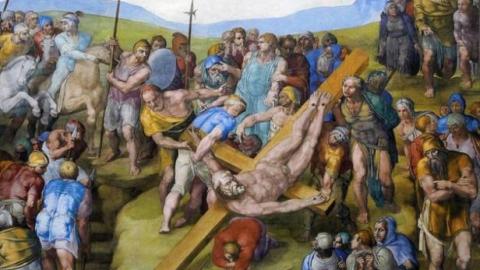Guilt Trip: Robert Snyder’s “Michelangelo: Self-Portrait”

Michelangelo spent most of his life on a massive guilt trip. When he painted The Crucifixion of St. Peter in 1550 (pictured), he inserted not one, but two self-portraits. To the left of the martyr, a young Michelangelo stands beside a soldier gesturing to the cross, as if Michelangelo were responsible for what was happening for his years of following the pagan ideals of beauty over the glory of God. To the right of the martyr, an old Michelangelo stands disconsolate, realizing the cost of his embracing God over the god of beauty too late.
Robert Snyder’s 1989 film Michelangelo: Self-Portrait, finally available on DVD from Microcinema, takes us along this long guilt trip as he presents these and many more self-portraits in vivid detail along with Michelangelo’s own self-portrait in words from his diaries and poems. In this film we step inside the mind, heart, and soul of a titan of the Renaissance and shed light on the long shadow he continues to cast on our culture.
Snyder filmed this portrait of Michelangelo over the course of 10 years. It begins with Michelangelo writing about his final self-portrait in the Florentine Pieta in which he cast himself as Nicodemus, the man who donated his own tomb to house Christ’s fallen body. Snyder then wheels back to the beginnings of Michelangelo’s life, showing the Caprese landscape of his childhood home and the stone quarries that became his life-long obsession. This beautiful cinematography soon centers around the works of art themselves, giving us a close-up of the master rarely seen before. Snyder gained permission from the Vatican to film the Pietafrom behind its protective glass for the first time since 1972. Michael Sonnabend’s sensitive and masterful selection of texts from Michelangelo’s diaries and poems as well as his contemporary biographers allows Michelangelo to speak for himself without the intermediary of art critics. Just as Snyder brought the glass wall between us and the Pieta down, Sonnabend brought down the wall of interpretation to allow us full access to the genius’ mind and spirit.
It’s illustrative to view the DVD extra of The Titan: The Story of Michelangelo, a 1951 documentary that won the Academy Award for Best Documentary that year. Snyder produced that film, but it pales by comparison to his second effort to capture Michelangelo on film, and not just because the 1951 version is in black and white. In 1951, Snyder chose to tell the story too much by himself, whereas in 1989 he allows Michelangelo the first, and final, say. Placing the two films side by side will show you, too, how far Snyder had come in realizing how to sculpt a portrait of the great sculptor.
Unfortunately, Snyder filmed before the restoration of the ceiling of the Sistine Chapel, so the images in those scenes lack the pop and verve we now experience post-restoration. (Treat yourself to the Vatican’s new virtual tour of the Sistine Chapel to see what I mean.) However, the loving attention he pays to the sculpture spanning Michelangelo’s career. From the highly finished renderings of his youthful obsession with beauty to the unfinished, almost raw renderings of his old age’s obsession with the crucifixion and God, Michelangelo grew as a person and an artist. Robert Snyder’s Michelangelo: Self-Portrait takes the full measure of the man as few other artists have ever done.
[Image: Michelangelo’s The Crucifixion of St. Peter (1550).]
[Many thanks to Microcinema for providing me with a review copy of Robert Snyder’s film Michelangelo: Self-Portrait.]





